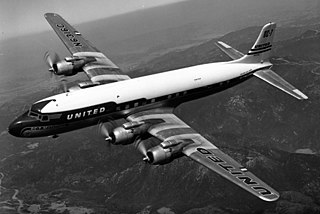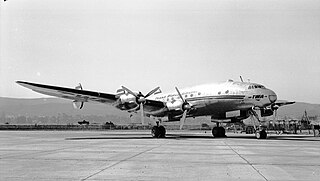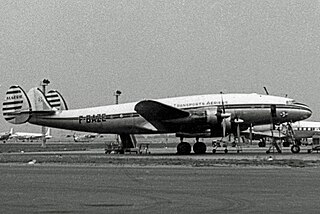
Trans World Airlines (TWA) was a major airline in the United States that operated from 1930 until it was acquired by American Airlines in 2001. It was formed as Transcontinental & Western Air to operate a route from New York City to Los Angeles via St. Louis, Kansas City, and other stops, with Ford Trimotors. With American, United, and Eastern, it was one of the "Big Four" domestic airlines in the United States formed by the Spoils Conference of 1930.

The Lockheed Constellation ("Connie") is a propeller-driven, four-engined airliner built by Lockheed Corporation starting in 1943. The Constellation series was the first pressurized-cabin civil airliner series to go into widespread use. Its pressurized cabin enabled commercial passengers to fly well above most bad weather for the first time, thus significantly improving the general safety and ease of air travel.

The Douglas DC-7 is an American transport aircraft built by the Douglas Aircraft Company from 1953 to 1958. A derivative of the DC-6, it was the last major piston engine-powered transport made by Douglas, being developed shortly after the earliest jet airliner—the de Havilland Comet—entered service and only a few years before the jet-powered Douglas DC-8 first flew in 1958. Unlike other aircraft in Douglas's line of propeller-driven aircraft, no examples remain in service in the present day, as compared to the far more successful DC-3 and DC-6.

On December 16, 1960, a United Airlines Douglas DC-8 bound for Idlewild Airport in New York City collided in midair with a TWA Lockheed L-1049 Super Constellation descending toward LaGuardia Airport. The Constellation crashed on Miller Field in Staten Island and the DC-8 in Park Slope, Brooklyn, killing all 128 aboard the two aircraft and six people on the ground. The accident was the world's deadliest aviation disaster at the time, and remains the deadliest accident in the history of United Airlines.

TWA Flight 843 was a scheduled Trans World Airlines passenger flight that crashed after an aborted takeoff from John F. Kennedy International Airport to San Francisco International Airport (California) in July 1992. Despite an intense fire after the crash, the crew was able to evacuate all 280 passengers from the aircraft. There was no loss of life, although the aircraft was destroyed by the fire.

The Grand Canyon mid-air collision occurred in the western United States on June 30, 1956, when a United Airlines Douglas DC-7 struck a Trans World Airlines Lockheed L-1049 Super Constellation over Grand Canyon National Park, Arizona. The first one fell into a canyon and the other one slammed into a rock face. All 128 on board both airplanes perished, making it the first commercial airline incident to exceed one hundred fatalities. The airplanes had departed Los Angeles International Airport minutes apart from each other and headed for Chicago and Kansas City, respectively. The collision took place in uncontrolled airspace, where it was the pilots' responsibility to maintain separation. This highlighted the antiquated state of air traffic control, which became the focus of major aviation reforms.

The 1965 Carmel mid-air collision occurred on December 4, 1965, when Eastern Air Lines Flight 853 (N6218C), a Lockheed Super Constellation en route from Boston Logan International Airport to Newark International Airport, collided in mid-air with Trans World Airlines Flight 42 (N748TW), a Boeing 707-131B en route from San Francisco International Airport to John F. Kennedy International Airport, over Carmel, New York, United States.

TWA Flight 529 was a Lockheed Constellation L-049 propliner, registration N86511, operating as a scheduled passenger service from Boston, Massachusetts to San Francisco, California. On September 1, 1961, at 02:05 CDT, the flight crashed shortly after takeoff from Midway Airport in Chicago, killing all 73 passengers and five crew on board; it was at the time the deadliest single plane disaster in U.S. history.
Air France has been in operation since 1933. Its aircraft have been involved in a number of major accidents and incidents. The deadliest accident of the airline occurred on June 1, 2009, when Air France Flight 447, an Airbus A330-203, flying from Rio de Janeiro to Paris crashed into the Atlantic Ocean with 228 fatalities. A selected list of the most noteworthy of these events is given below.
Several aviation incidents and accidents have occurred in which the control surfaces of an aircraft became disabled, often due to failure of hydraulic systems or the flight control system. Other incidents have occurred where controls were not functioning correctly prior to take-off, either due to maintenance or pilot error, and controls can become inoperative from extreme weather conditions. Aircraft are not designed to be flown in such circumstances; however, a small number of pilots have had some success in flying and landing aircraft with disabled controls.

The Lockheed L-1649 Starliner was the last model of the Lockheed Constellation line of airliners. Powered by four Wright R-3350 TurboCompound engines, it was built at Lockheed's Burbank, California plant from 1956 to 1958.

The Lockheed L-049 Constellation was the first model of the Lockheed Constellation aircraft line. It entered service as the C-69 military transport aircraft during World War II for the United States Army Air Forces and was the first civilian version after the war. When production ended in 1946 it was replaced by the improved L-649 and L-749 Constellation.

The Lockheed L-649 Constellation was the first real civilian version of the Lockheed Constellation line, as the Lockheed L-049 Constellation was a simple redesign from the military Lockheed C-69 Constellation. The L-649 was planned to be the new standard version of the Constellation, but the L-749 Constellation, a co-jointly produced improved derivative, was chosen over the L-649 by most airlines. Most of the few L-649 aircraft built were delivered and operated by Eastern Air Lines.

On 1 September 1953, an Air France Lockheed L-749 Constellation, registered in France as F-BAZZ, flying Flight 178, a scheduled flight from Paris to Nice, crashed into the Pelat Massif in the French Alps near Barcelonnette on the first stage of the flight, between Orly Airport and Nice Airport. All 42 on board were killed, nine crew and 33 passengers including the French violinist Jacques Thibaud and the French pianist René Herbin.

British Overseas Airways Corporation (BOAC) was the British state-owned airline created in 1939 by the merger of Imperial Airways and British Airways Ltd. It continued operating overseas services throughout World War II. After the passing of the Civil Aviation Act 1946, European and South American services passed to two further state-owned airlines, British European Airways (BEA) and British South American Airways (BSAA). BOAC absorbed BSAA in 1949, but BEA continued to operate British domestic and European routes for the next quarter century. The Civil Aviation Act 1971 merged BOAC and BEA, effective 31 March 1974, forming today's British Airways.

Air France Flight 152 (AF152) was a scheduled international passenger flight which made an emergency water landing in the Mediterranean Sea, off Fethiye, South-Western Turkey on 3 August 1953. The aircraft sank over an hour after ditching. Four passengers died, out of 8 crew and 34 passengers.

TWA Flight 595 was a cargo flight operated from Chicago-Midway Airport in Illinois to Los Angeles International Airport in California. On 24 November 1959 the Lockheed L-1049H Super Constellation operating the flight received a fire warning in its No. 2 engine shortly after departure at Chicago-Midway Airport in cloudy weather and requested to turn back. While turning onto their final approach path they banked excessively exceeding 45 degrees and started rapidly sinking. The aircraft impacted the ground in a residential area at 5:35 am CST about a quarter mile southeast of the airport, killing all 3 crewmembers on board and 8 people on the ground.
















